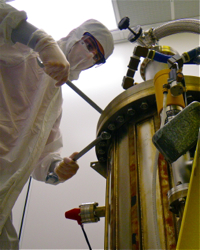BCS Surface Resistance
SRIMP
This webpage calculates BCS surface resistance under wide range of conditions, and is based on a program by Jurgen Halbritter. [J. Halbritter, Zeitschrift für Physik 238 (1970) 466]
Enter material parameters below, and click submit to calculate the BCS surface resistance. Results are given in a new window.
Please be aware that frequencies much lower than 1 MHz may cause substantial processing times
(depending on the user's computer).
About Srimp
SRIMP is a program written by Jurgen Halbritter to calculate the BCS surface resistance of a superconductor. The method of calculation incorporates the full BCS theory. Five material parameters are required to describe the superconductor:
- The superconducting transition temperature
- The energy of the superconducting gap (entered as Delta(T=0)/kTc)
- The London penetration depth, Lamda, at T=0
- The coherence length, Xi, at T=0
- The electron mean free path, l, at 4.2K
The default values for these parameters are those of 200 RRR niobium. Additional input data required are:
- The frequency (entered in MHz)
- The temperature at which calculations are to be made
- The degree of accuracy desired in the solutions
The default accuracy of .001 gives acceptable solutions for most applications.
Acknowledgements: The code featured on this webpage is a "translation" of Jurgen Halbritter's original FORTRAN code into Javascript [J. Halbritter, Zeitschrift für Physik 238 (1970) 466]. This translation was done by Hunter Swan, a Cornell undergrad students who worked in our group during the spring of 2012.

High temperature vacuum furnace for the production of Nb3SN via vapor diffusion.
